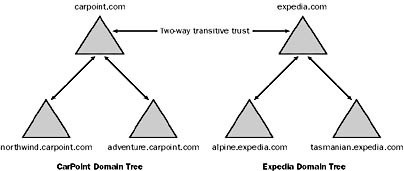Hey there! I see you’re curious about ‘domain forests’. Maybe you stumbled upon the term while tackling a networking project, or perhaps it’s part of your computer science coursework. Whatever the case, you’re in the right place to unravel this concept. In this article, we’re going to explore what domain forests are, why they matter in the vast landscape of computer networking, and how they fit into the broader picture of network administration. So, let’s decode this together!
In this article:

1. What Exactly is a Domain Forest?
Imagine you’re building a giant digital kingdom. In this kingdom, a Domain Forest is like the overarching realm that contains multiple territories (domains). Each domain is a collection of objects – users, computers, printers – under a common database. But what makes a Forest special is its ability to connect these diverse domains into a cohesive unit, allowing for streamlined administration and security.
Microsoft Windows Server environments
In the world of Microsoft Windows Server environments, a Domain Forest is a key player. Imagine you’re the ruler of a vast digital empire. In this empire, a Domain Forest represents the highest-level organizational structure in your Active Directory (AD) setup. It’s like the overarching government that sets the rules and manages resources for smaller territories (domains) within it.
So, what’s happening inside this Domain Forest? It’s a collection of one or more domain trees. Each domain in these trees is a unique administrative unit, with its own set of rules and policies, known as the domain’s schema and configuration. The domains in a forest share a common schema, which is like the DNA for the objects in the forest – defining attributes and types of resources like users, computers, and printers.
But there’s more! The Domain Forest in a Microsoft Windows Server environment is not just a static structure. It has a Global Catalog, which is like the master index of all the information in the forest. It ensures that when a user in one domain needs to access resources in another, they can find it swiftly.
Think of it as an intelligent network manager. It ensures that all domains in the forest can trust each other through transitive trusts, simplifies resource sharing, and maintains the overall security and integrity of your digital kingdom. Pretty cool, right?
2. Structure of a Domain Forest
Now, let’s picture the structure of this mighty Domain Forest. Imagine it as a giant tree with many branches and leaves. Each branch is a domain tree – a collection of domains that are connected in a hierarchical structure.
Here’s where it gets interesting: Each domain tree starts with a root domain. From this root, you can create child domains, and these child domains can have their own child domains, forming a branching structure. It’s like a family tree, but for domains!
But what binds these diverse domain trees together in a forest? It’s their shared schema, which defines the object types they can contain, and a shared configuration container, dictating how things are done across the forest. This shared framework ensures consistency and harmony across the entire Domain Forest.
And guess what? This structure isn’t just for show. It provides logical isolation within the same physical infrastructure. This means different departments or groups within an organization can have their own domain, with tailored policies and access controls, while still being part of the larger forest. It’s the ultimate balance of autonomy and unity!
In essence, the structure of a Domain Forest in a Microsoft Windows Server environment is a marvel of organization and efficiency. It’s designed to handle the complexities of large-scale network management, ensuring that each domain tree coexists, collaborates, and thrives under the same digital canopy. It’s not just a technical setup; it’s an ecosystem where every part works together to create a seamless, secure, and efficient network environment.
3. Why Domain Forests Matter
“But why should I care about Domain Forests?” you might ask. Well, in the grand scheme of networking, they are like the backbone of efficient network management, especially in large organizations. They simplify user management, enhance security, and provide a scalable way to keep the digital kingdom orderly.
Forests provide a way of administering enterprise networks for a company whose subsidiaries each manage their own network users and resources. For example, a company called CarPoint might have a domain tree with the root domain carpoint.com, while a subsidiary company called Expedia might have a domain tree with the root domain expedia.com. Note that these two companies do not share a contiguous portion of the DNS namespace; this is typical of trees in a forest.
The two companies might want to administer their own users and resources but make those resources available to each other’s users. They can combine the two domain trees into a forest by establishing a two-way transitive trust between the root domains of the two trees.

All trees in a forest must share a common directory schema and global catalog. The global catalog holds information about all objects in all domains of the forest and acts as an index of all users and resources for all domains in the forest.
By searching the global catalog, a user in one domain can locate resources anywhere in the forest. The global catalog contains only a subset of the attributes of each object. This ensures fast searches for users trying to locate network resources.
4. References
- “Windows Server Administration Fundamentals” by Microsoft Official Academic Course.
- “Mastering Active Directory” by Dishan Francis.